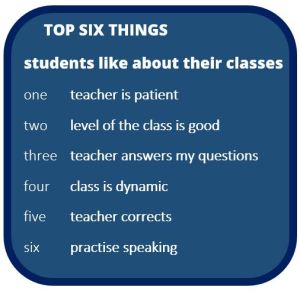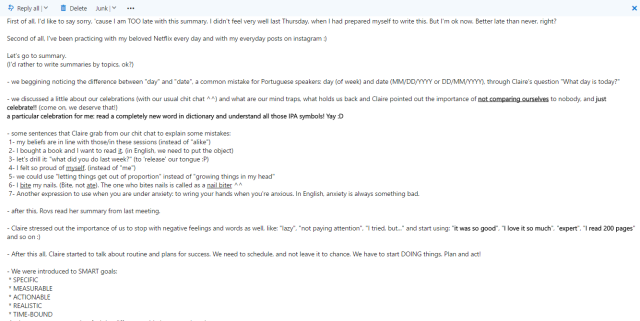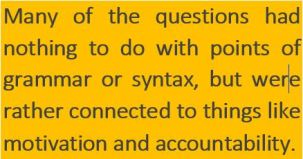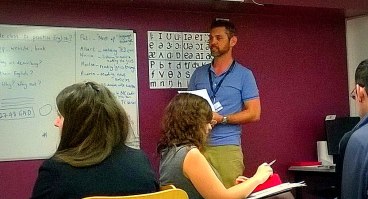At the InnovateELT conference this year titled “Power to the Learner”, I asked the question, ‘What do students say they get from their teacher?’. I wanted to know how closely their experience aligns with what the ELT profession says about good teaching.
I looked at feedback from about 100 students at Oxford House who were asked to write down three things they liked about their classes. The students are mainly Spanish / Catalan adults in a private language school in Barcelona in small groups at a range of levels including general English and exam preparation classes.
So here are the top 6 most mentioned. You might be surprised by the results.
- The teacher is patient.
- The level of the class is good for me.
- The teacher resolves my doubts. (Spanglish for “the teacher answers my questions”, yet somehow much more poetic!)
- The class is dynamic.
- The teacher corrects when we do mistakes (sic).
- We practise speaking.
Looking at these results my initial reaction was akin to that Eurovision song contest experience when some terrible dirge inexplicably wins and all the songs you liked are nowhere in sight. Do my years of classroom experience, ELT qualifications, dedication to professional development amount to nothing? Where is language awareness in there? What about teaching techniques, etc, etc, etc… None of this seems to matter. According to this feedback, I just need to be patient! Seriously? All I need to do is be patient!?
When I reflected a bit more on patience and what it might mean, I calmed down a bit. I thought about the work of my daughter’s tennis coach and the hours of knocking balls back to her and her classmates. Patience includes empathy for the endeavour and encouragement when she gets frustrated. The Irish refer to one to one classes as “grinds”. This is what teachers do, we grind out results, we are patient.
My daughter’s tennis teacher also gets a tick in the other five categories by the way. (substituting tennis for speaking in number six of course!) And his work is well done with those six areas covered. I wonder, then, why English teachers need more than six categories to assess their competence and why are we using language to describe things we do which doesn’t match what the learners call those things? Teachers say they develop communicative competence, students say they practise speaking. Teachers develop critical thinking skills, students enjoy discussing interesting topics. Teachers discuss mobile learning, students do homework on the bus. Teachers plan a task cycle, students have a conversation and get some correction. And so on.
 What would happen if we aligned the language we use to describe what we do with the language our students use to describe what we do? Imagine, for example, that the students’ top six feedback points listed above (or something like it) were the observation checklist for teachers on CELTA and DELTA courses, or chapter headings in Jeremy Harmer’s “How to Teach English”. Imagine teachers talked about teaching in a way that a B1 student would understand. Imagine that students as well as teachers and teacher trainers participated in giving feedback to teachers or even assessing them? Would that give power to the learners and would it be good for them?
What would happen if we aligned the language we use to describe what we do with the language our students use to describe what we do? Imagine, for example, that the students’ top six feedback points listed above (or something like it) were the observation checklist for teachers on CELTA and DELTA courses, or chapter headings in Jeremy Harmer’s “How to Teach English”. Imagine teachers talked about teaching in a way that a B1 student would understand. Imagine that students as well as teachers and teacher trainers participated in giving feedback to teachers or even assessing them? Would that give power to the learners and would it be good for them?
Something else I noticed about the student top six is the absence of any reference to methodology. Point four about the class being dynamic I think refers to the class being participative and varied as opposed to chalk and talk lectures from the front which many students have experienced in language classes at school. Isn’t it sad that ELT has failed to grasp or at least failed to put into practice what to tennis coaches and music teachers is obvious, namely that to improve a skill you need to practise doing it, and practise it a lot. The ELT methodology wars of the 20th century and skirmishes of the 21st seem to have escaped our learners, fortunately for them, if this top six is anything to go by. No mention by them of the audio-lingual method, grammar translation, direct method, dogme, communicative approaches, learner autonomy, lexical approach, TBL, PPP, TTT, OHE, NLP, ARC, OMG…
I am reminded of a line from a favourite band of mine from the late 80s, Carter USM, “If love is the answer, what was the question?” This makes a great substitution drill to start a conversation about why we and our students do what we do and what other options there are on offer to achieve the same aims. If the communicative approach is the answer what was the question? If an IWB is the answer what was the question? And so on. Let’s try one.
Teacher A: If learner autonomy is the answer, what was the question?
Teacher B: Maybe something like, how can we help students practise more on their own? How can students get more benefit from their time in class? How can students motivate themselves?
Looking at this conversation it strikes me that teacher B’s questions are compelling in that they directly address practical concerns for teachers and students in clearly comprehensible language. The answer “learner autonomy”, therefore seems more mystifying than enlightening.
To conclude here are three questions I had after reflecting on this research:
- Are English teachers overcomplicating when we describe and discuss what we do, taking us further away from each other, our students and an understanding of our work?
- If learning English is like learning tennis, why don’t we teach it that way?
Should we be aligning our language (and thinking) with students to facilitate the inevitably collaborative endeavour of creating a language class?
(This article was written by Duncan)

 Gabriella is an ACC, ICF-accredited language coach (Associate Certified Coach with the International Coach Federation) and business communication trainer. Her declared mission is to add dimension to ongoing language learning practices by introducing language coaching to organizations. She is currently supporting teachers to implement a language coaching approach in their day-to-day classes in Budapest, Hungary.
Gabriella is an ACC, ICF-accredited language coach (Associate Certified Coach with the International Coach Federation) and business communication trainer. Her declared mission is to add dimension to ongoing language learning practices by introducing language coaching to organizations. She is currently supporting teachers to implement a language coaching approach in their day-to-day classes in Budapest, Hungary.
 Another guest post, this time from Claire Venables, who is based in Brazil and runs
Another guest post, this time from Claire Venables, who is based in Brazil and runs  This is something that is essential in a Mastermind meeting and, when applied to my English lessons, has been incredibly empowering for the members of my group. Different from a traditional format where the teacher gives feedback to the students on their language production, the entire group gets involved with generating ideas and solutions and feedback. All members are there to ask for help and give help in a full and balanced way and this has transformed the dynamics of my lessons and really made the learners more actively involved in their own learning process and that of their classmates.
This is something that is essential in a Mastermind meeting and, when applied to my English lessons, has been incredibly empowering for the members of my group. Different from a traditional format where the teacher gives feedback to the students on their language production, the entire group gets involved with generating ideas and solutions and feedback. All members are there to ask for help and give help in a full and balanced way and this has transformed the dynamics of my lessons and really made the learners more actively involved in their own learning process and that of their classmates.
 Rovena was having a hard time finding the courage to record herself speaking in English until her classmate Gabriel offered to help her. His may not be as fluent as Rovena but he feels much more confident in front of a camera. They pooled their skills and supported each other and made this great video. Rovena has begun helping Gabriel with his writing, a goal he has for his English.
Rovena was having a hard time finding the courage to record herself speaking in English until her classmate Gabriel offered to help her. His may not be as fluent as Rovena but he feels much more confident in front of a camera. They pooled their skills and supported each other and made this great video. Rovena has begun helping Gabriel with his writing, a goal he has for his English. is approach to learning and how it meshes with From English Teacher to Learner Coach, his background in learning languages, his move to coaching others in languages, not to mention a wonderful tool that he has built for learners:
is approach to learning and how it meshes with From English Teacher to Learner Coach, his background in learning languages, his move to coaching others in languages, not to mention a wonderful tool that he has built for learners:  e parents who studied the language spoken in whatever new country we moved to, and this gave me the lived experience and confidence that learning languages was something that could be done.
e parents who studied the language spoken in whatever new country we moved to, and this gave me the lived experience and confidence that learning languages was something that could be done. and acquaintances. Many (if not most) of the questions, had nothing to do with points of grammar or syntax, but were rather connected to things like motivation and accountability.
and acquaintances. Many (if not most) of the questions, had nothing to do with points of grammar or syntax, but were rather connected to things like motivation and accountability.


